
The Sui Dynasty 581 ∼ 618 AD
About the Sui Dynasty
During this time, there was a desire to reunite China again and restore the country to the former glory that the Han Dynasty (206BC ∼ 220AD) enjoyed. A general from the Northern Zhou Dynasty was successful in overthrowing the last Southern Dynasty (Chen) in 581 AD. This general adopted the reign title of “Sui Wendi,” or emperor Wen, thus establishing the Sui Dynasty. However, this dynasty was short lived due to the problems stemming from peasant revolts and the burden of a military campaign launched against Korea. Sui Wendi’s successor, Sui Yangdi was overthrown and the Tang Dynasty was established in 618 AD.
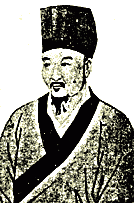 Chao Yuangfang (c. 610 AD) was a taiyi,which was the title for the emperor’s physician. He is most famous for his book entitled Treatise on the Causes and Symptoms of Diseases (zhu bing yuan hou lun). This book is comprised of 50 volumes and describes 1,700 syndromes. It is significant because it is the earliest record in China that categorizes the causes, symptoms and pathology of certain diseases in a systematical manner. It touches on subjects concerning internal medicine, surgery, pediatrics, gynecology, dermatology, ophthalmology, and ENT.
Chao Yuangfang (c. 610 AD) was a taiyi,which was the title for the emperor’s physician. He is most famous for his book entitled Treatise on the Causes and Symptoms of Diseases (zhu bing yuan hou lun). This book is comprised of 50 volumes and describes 1,700 syndromes. It is significant because it is the earliest record in China that categorizes the causes, symptoms and pathology of certain diseases in a systematical manner. It touches on subjects concerning internal medicine, surgery, pediatrics, gynecology, dermatology, ophthalmology, and ENT.
The Tang Dynasty 618 ∼ 907 AD
About the Tang Dynasty
The Tang Dynasty was founded by the Li family. Li Yuan, the first emperor of the Tang Dynasty, reigned under the name Tang Gaozu (618 ∼ 626 AD) followed by his son Li Shimin who reigned under the name Tang Taizong (626 ∼ 649 AD). The early Tang Dynasty expanded China making it the most powerful Asian country. During this time, Buddhism was at its peak and Chinese poetry flourished.
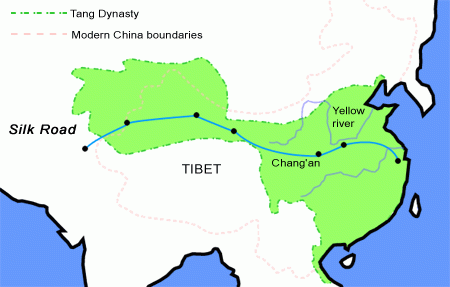
The Imperial Academy
In 624 AD, another Imperial Medical Academy was founded. This government run academy graduated doctors for the purpose of serving the emperor, his family, and the nobles. It was a large institution divided into two areas: medicine and pharmacy.
 Medicine: Those students who studied medicine were required to take general subjects that focused on classics such as the Yellow Emperor’s Classic of Internal Medicine, Shen Nong's Classic of Herbal Medicine, Pulse Classic (mai jing), and ABC of Acupuncture and Moxibustion. Clinical subjects studied included areas such as internal medicine, pediatrics, surgery, ENT, cupping, acupuncture, massage and charms and incantations. This last subject (charms and incantations) arose out of the influences of Taoism and Buddhism on Chinese culture, and is significant because it reflected the importance that spiritualism played in the holistic healing process.
Medicine: Those students who studied medicine were required to take general subjects that focused on classics such as the Yellow Emperor’s Classic of Internal Medicine, Shen Nong's Classic of Herbal Medicine, Pulse Classic (mai jing), and ABC of Acupuncture and Moxibustion. Clinical subjects studied included areas such as internal medicine, pediatrics, surgery, ENT, cupping, acupuncture, massage and charms and incantations. This last subject (charms and incantations) arose out of the influences of Taoism and Buddhism on Chinese culture, and is significant because it reflected the importance that spiritualism played in the holistic healing process.
Pharmacy: Those students studying pharmacy helped maintain the Imperial Academy’s herb garden and learned how to plant and process herbs. Upon graduation, they were made herb gardeners.
Examination Process: One of the most important aspects of this school was the examination process that all students were required to go through. There were seasonal and yearly examinations of all the subjects studied. If a student failed the final examination required for graduation, he was dismissed from the academy. Doctors were promoted based on their treatment success rate. The implementation of exams to qualify doctors may have been a catalyst for Western countries to adopt their own examination process. In 931 AD, the Arabs began requiring qualifying examinations for medical practitioners, and in 1140 AD Roger of Sicily (a short-lived but culturally rich kingdom in Norman Sicily) passed laws requiring state examinations for doctors in Italy. 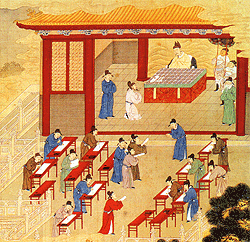
By 629 AD, just five years after the Imperial Medical Academy was established, emperor Tai zong established local medical schools to educate the doctors in the outlying provinces. By 713 AD, China’s local government was assigning assistant teachers to these schools, and by 723 AD the local government’s power expanded so that they had the authority to appoint medical doctors to serve the lay public. As a result, apprenticeships were not the only means for local doctors to learn medicine as formalized medical education became popular.
The First Official Pharmacopoeia
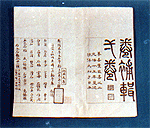 The previously mentioned the Shen Nong’s Classic of Herbal Medicine written in approximately the 1st and 2nd century BC is the earliest herbal reference. It was later revised by Tao Hongjing (456∼536 AD) as the Variorum of the Classic of Herbal Medicine (shen nong ben cao jing hiz zhu). While both of these works are very important, the authors wrote these books of their own accord because of their passion for medicine. It was not until the Tang Dynasty that the first official pharmacopoeia was mandated by the government. A physician named Su Jing, along with approximately 20 other of his compatriots wrote the Newly Revised Materia Medica (xin xiu ben cao) between 657∼659 AD, which was the first official pharmacopoeia in China and in the world. Western cultures would not have official pharmacopoeias until several centuries later.
The previously mentioned the Shen Nong’s Classic of Herbal Medicine written in approximately the 1st and 2nd century BC is the earliest herbal reference. It was later revised by Tao Hongjing (456∼536 AD) as the Variorum of the Classic of Herbal Medicine (shen nong ben cao jing hiz zhu). While both of these works are very important, the authors wrote these books of their own accord because of their passion for medicine. It was not until the Tang Dynasty that the first official pharmacopoeia was mandated by the government. A physician named Su Jing, along with approximately 20 other of his compatriots wrote the Newly Revised Materia Medica (xin xiu ben cao) between 657∼659 AD, which was the first official pharmacopoeia in China and in the world. Western cultures would not have official pharmacopoeias until several centuries later.
Foreign Influences on Chinese Medicine Development
Due to China’s expansion and improvement in communication and transportation systems, Chinese medicine was introduced into foreign cultures. In return, these foreign cultures contributed to the advancement of Chinese medicine by expanding its knowledge base. Chinese doctors were sent to countries such as Korea, Japan, India and Vietnam, and many of the previously mentioned Chinese medical texts were exported and translated into these countries’ languages. From Korea, herbs such as ginseng , rhizoma typhonii (bai fu zi), Korean pine and others were introduced into China. From Vietnam came vanilla grass, sappan wood, and cloves.
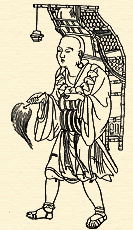
Due to the popularity of Buddhism and the frequent pilgrimages of religious monks, a natural exchange of information occurred between China and India. Many Indian medical books were translated into Chinese, and Indian doctors were known to practice in China. Advancements in ophthalmology were in part attributed to Indian experience. In return, herbs such as ephedra, ginseng, and angelica were brought from China to India.
Chinese medicine also influenced the Arab world as Arab merchants made their way into China. The Arabs brought back alchemy and Pulsology techniques as well as herbs such as rhubarb and cinnamon while new substances such as incense, myrrh, and Trigonella foenum-graecum (hu lu ba) were given to China. The fig (Ficus carica), which is known for its laxative properties and is still used in Chinese medicine today, came from Persia. Tibetan medicine also benefited greatly from both Chinese and Indian influences.
Sun Simiao (581∼682 AD)
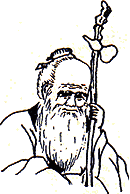 Sun Simao is one of the most influential physicians in the history of Chinese medicine, and is distinguished by his application of medicine and his adherence to 828" href="#">ethical code. His interest in medicine came from his own fragile health whereby he treated himself as his first patient. His mastery of medicine, Buddhism, Confucianism, and Taoism made Emperor Wen of the Sui Dynasty, and Emperors Tai-zong and Gao-zu of the Tang Dynasty seek him out as an imperial physician. However, Sun Simiao declined these posts and devoted his life to being a physician who served the common people. He believed the best way to care for a patient was to prevent an illness before it occurred. The worst care was to treat an illness that had already occurred because it meant that he was unable to keep his patient healthy.
Sun Simao is one of the most influential physicians in the history of Chinese medicine, and is distinguished by his application of medicine and his adherence to 828" href="#">ethical code. His interest in medicine came from his own fragile health whereby he treated himself as his first patient. His mastery of medicine, Buddhism, Confucianism, and Taoism made Emperor Wen of the Sui Dynasty, and Emperors Tai-zong and Gao-zu of the Tang Dynasty seek him out as an imperial physician. However, Sun Simiao declined these posts and devoted his life to being a physician who served the common people. He believed the best way to care for a patient was to prevent an illness before it occurred. The worst care was to treat an illness that had already occurred because it meant that he was unable to keep his patient healthy.
Sun Simiao’s best known works are Essential Prescriptions Worth a Thousand Gold (qian jin yao fang), or Essential Prescriptions Worth a Thousand Gold in Emergencies (bei ji qian jin yao fang) and the A Supplement to the Essential Prescriptions Worth a Thousand Gold (qian jin yin fang). The first book is comprised of 30 volumes and lists 5,300 prescriptions. The second book is also made up of 30 volumes and lists 2,571 prescriptions. Sun Simiao’s observations about diseases and his prescribed treatments are noteworthy even today. For example, he knew cholera and diarrhea were caused by what people ate and drank and not by “evil spirits” as was commonly thought. He correctly identified tuberculosis as a lung disease, which was a new concept of this time. After successfully treating 600 cases of leprosy, he is considered the earliest expert on this disease in China.
Sun Simiao is also renowned for his identification and treatment of deficiency disorders. Even though he was not exactly sure of the cause of goiter (hypothyroidism caused by lack of iodine), he knew it occurred in people who lived in certain mountainous regions and drank unsanitary water. He prescribed medicine from the thyroid glands of deer and sheep because they are high in iodine content. Nyctalopia, which is night blindness caused by lack of vitamin A, was successfully treated with pig, calf and sheep livers that contain large amounts of this vitamin. He is the first person in the medical history to document the diagnosis, treatment, and prevention of Beriberi, a deficiency disease caused by lack of vitamin B1. For this, he prescribed combinations of herbs that were high in Vitamin B1.
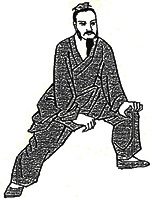 The elderly also benefited from Sun Simiao because he was a strong advocate for maintaining health throughout a person’s lifestyle. He thought life could be prolonged with measures such as performing daily breathing exercises (qi gong), regular physical exercise, and massage therapy. He advised against excessive drinking, eating raw meat, and spitting in public. He also believed diet therapy should be tried before resorting to medicine.
The elderly also benefited from Sun Simiao because he was a strong advocate for maintaining health throughout a person’s lifestyle. He thought life could be prolonged with measures such as performing daily breathing exercises (qi gong), regular physical exercise, and massage therapy. He advised against excessive drinking, eating raw meat, and spitting in public. He also believed diet therapy should be tried before resorting to medicine.
Other advances made by Sun Simiao were in the areas of acupuncture, moxibustion and pharmacy. He thought moxibustion should be performed prior to acupuncture, and he was successful in determining essential acupuncture points. Sun Simiao also combined acupuncture with drug therapy, and stressed using the a-shi point, which is still used by acupuncturists today. His knowledge of herbs was vast, and he insisted on harvesting them in the proper geographic locations and seasons and also using them after collect processing methods. The nickname “king of pharmacology” or ‘king of medicinal herbs” was given to him because he was especially knowledgeable in medicinal herbs.

 Chao Yuangfang (c. 610 AD) was a taiyi,which was the title for the emperor’s physician. He is most famous for his book entitled Treatise on the Causes and Symptoms of Diseases (zhu bing yuan hou lun). This book is comprised of 50 volumes and describes 1,700 syndromes. It is significant because it is the earliest record in China that categorizes the causes, symptoms and pathology of certain diseases in a systematical manner. It touches on subjects concerning internal medicine, surgery, pediatrics, gynecology, dermatology, ophthalmology, and ENT.
Chao Yuangfang (c. 610 AD) was a taiyi,which was the title for the emperor’s physician. He is most famous for his book entitled Treatise on the Causes and Symptoms of Diseases (zhu bing yuan hou lun). This book is comprised of 50 volumes and describes 1,700 syndromes. It is significant because it is the earliest record in China that categorizes the causes, symptoms and pathology of certain diseases in a systematical manner. It touches on subjects concerning internal medicine, surgery, pediatrics, gynecology, dermatology, ophthalmology, and ENT.
 Medicine: Those students who studied medicine were required to take general subjects that focused on classics such as the Yellow Emperor’s Classic of Internal Medicine, Shen Nong's Classic of Herbal Medicine, Pulse Classic (mai jing), and ABC of Acupuncture and Moxibustion. Clinical subjects studied included areas such as internal medicine, pediatrics, surgery, ENT, cupping, acupuncture, massage and charms and incantations. This last subject (charms and incantations) arose out of the influences of Taoism and Buddhism on Chinese culture, and is significant because it reflected the importance that spiritualism played in the holistic healing process.
Medicine: Those students who studied medicine were required to take general subjects that focused on classics such as the Yellow Emperor’s Classic of Internal Medicine, Shen Nong's Classic of Herbal Medicine, Pulse Classic (mai jing), and ABC of Acupuncture and Moxibustion. Clinical subjects studied included areas such as internal medicine, pediatrics, surgery, ENT, cupping, acupuncture, massage and charms and incantations. This last subject (charms and incantations) arose out of the influences of Taoism and Buddhism on Chinese culture, and is significant because it reflected the importance that spiritualism played in the holistic healing process.
 The previously mentioned the Shen Nong’s Classic of Herbal Medicine written in approximately the 1st and 2nd century BC is the earliest herbal reference. It was later revised by Tao Hongjing (456∼536 AD) as the Variorum of the Classic of Herbal Medicine (shen nong ben cao jing hiz zhu). While both of these works are very important, the authors wrote these books of their own accord because of their passion for medicine. It was not until the Tang Dynasty that the first official pharmacopoeia was mandated by the government. A physician named Su Jing, along with approximately 20 other of his compatriots wrote the Newly Revised Materia Medica (xin xiu ben cao) between 657∼659 AD, which was the first official pharmacopoeia in China and in the world. Western cultures would not have official pharmacopoeias until several centuries later.
The previously mentioned the Shen Nong’s Classic of Herbal Medicine written in approximately the 1st and 2nd century BC is the earliest herbal reference. It was later revised by Tao Hongjing (456∼536 AD) as the Variorum of the Classic of Herbal Medicine (shen nong ben cao jing hiz zhu). While both of these works are very important, the authors wrote these books of their own accord because of their passion for medicine. It was not until the Tang Dynasty that the first official pharmacopoeia was mandated by the government. A physician named Su Jing, along with approximately 20 other of his compatriots wrote the Newly Revised Materia Medica (xin xiu ben cao) between 657∼659 AD, which was the first official pharmacopoeia in China and in the world. Western cultures would not have official pharmacopoeias until several centuries later. 
 Sun Simao is one of the most influential physicians in the history of Chinese medicine, and is distinguished by his application of medicine and his adherence to 828" href="#">ethical code. His interest in medicine came from his own fragile health whereby he treated himself as his first patient. His mastery of medicine, Buddhism, Confucianism, and Taoism made Emperor Wen of the Sui Dynasty, and Emperors Tai-zong and Gao-zu of the Tang Dynasty seek him out as an imperial physician. However, Sun Simiao declined these posts and devoted his life to being a physician who served the common people. He believed the best way to care for a patient was to prevent an illness before it occurred. The worst care was to treat an illness that had already occurred because it meant that he was unable to keep his patient healthy.
Sun Simao is one of the most influential physicians in the history of Chinese medicine, and is distinguished by his application of medicine and his adherence to 828" href="#">ethical code. His interest in medicine came from his own fragile health whereby he treated himself as his first patient. His mastery of medicine, Buddhism, Confucianism, and Taoism made Emperor Wen of the Sui Dynasty, and Emperors Tai-zong and Gao-zu of the Tang Dynasty seek him out as an imperial physician. However, Sun Simiao declined these posts and devoted his life to being a physician who served the common people. He believed the best way to care for a patient was to prevent an illness before it occurred. The worst care was to treat an illness that had already occurred because it meant that he was unable to keep his patient healthy. The elderly also benefited from Sun Simiao because he was a strong advocate for maintaining health throughout a person’s lifestyle. He thought life could be prolonged with measures such as performing daily breathing exercises (qi gong), regular physical exercise, and massage therapy. He advised against excessive drinking, eating raw meat, and spitting in public. He also believed diet therapy should be tried before resorting to medicine.
The elderly also benefited from Sun Simiao because he was a strong advocate for maintaining health throughout a person’s lifestyle. He thought life could be prolonged with measures such as performing daily breathing exercises (qi gong), regular physical exercise, and massage therapy. He advised against excessive drinking, eating raw meat, and spitting in public. He also believed diet therapy should be tried before resorting to medicine.

